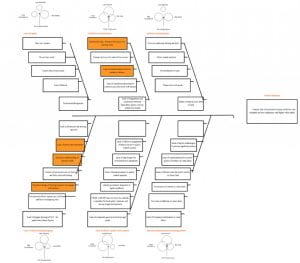Guest blog written by Sakineh Roodsari, Son Truong Can (Kenny), Dinh Quoc Cong, Nguyen Uyen, Phuoc Hung Thach, and Long Ho.
This team is made up of an independent group composed of 6 individuals coming from both the public and private sector. They are a multidisciplinary team of professionals who have worked in the following positions: the head of agricultural cooperatives and farm division – Department of Agriculture and Rural Development (DARD), a former manager of an agriculture cooperative in Tan Thanh Tay, director of Cu Chi High Tech Agriculture Cooperative, former World Bank consultant, project finance specialist, and as a facilitator of ASEAN SMEs Academy. They successfully completed the 15-week Practice of PDIA online course that ended in December 2018. This is their story.

How do we solve our wicked hard problem of farmers’ lack of motivation to learn, follow safe standards, and new techniques with higher value added? Although our team only has three members with experience in the agriculture sector, we all understood the urgency of working on this problem. In particular, because food safety is one of the biggest concerns in Vietnam, and the lack of food safety is the number one cause of cancer. Due to the agriculture inefficiencies in the value chain, it is difficult to tackle this problem using conventional methods.
This course taught us a series of toolkits that required innovative and experimental approaches to development, through a process called Problem Driven Iterative Adaptation (PDIA). During the first half of the course, we learned a lot of concepts. One particular term that really stuck was Isomorphic Mimicry. “Isomorphic mimicry is the tendency of governments to mimic other governments’ successes, replicating processes, systems, and even products of the “best practice” examples.” The governments appear capable, but in reality are not. So how do we step away from mimicry?
Rather than defining our problem and coming up with a solution, we constructed and deconstructed our problem by creating a Fishbone/Ishikawa diagram. The idea is for the problem to drive change, to mobilize agents behind its change, and to foster a search for solutions. This process forced us to persistently ask the question why in order to identify the six root causes of the problem. Through this process we were able to come up with multiple sub-causes. We then created a AAA Analysis by determining our Authority, Acceptance, and Ability for each cause. For causes that the AAA intersects, there is change space and space to start working (displayed in the Venn diagrams). Most of our causes had no change space, therefore we had to determine how to expand our AAA to create change space. This process required us to determine our key agents or stakeholders and how to engage with them to expand both our authority and acceptance. In the next step, we had to crawl our design space by evaluating existing and latent practices and determining forms of positive deviance. Finally, we were all set to start our first iteration.

In the PDIA process, it’s important to find small bite size areas to work on, which can achieve quick results. The idea is to keep the key agents excited, motivated, and empowered. We defined five sub-causes to get started (highlighted in orange in the Fishbone diagram). We then completed two iterations. During the first iteration, we went on a field visit and interviewed six farmers from the same Agriculture Cooperative in Cu Chi. After we conducted our interviews, we realized that our assumption about farmers lacking motivation may not hold. However, we also noted that the farmers we interviewed may not be a good sample to represent the majority of farmers in Ho Chi Minh City. Therefore, we decided to conduct more farmer interviews from other cooperatives in different districts. In our first iteration, we noted that the farmers prefer VinEco trainings to DARD’s.
In the second iteration, we interviewed a VinEco (private enterprise) training organizer and trainer of farmers. We had assumed correctly that the private trainers are more efficient than public trainers (DARD). Our interview process was very thorough for both the farmers and the trainer. It helped us discover what works and what doesn’t. However, we recognize that we have just started scratching only at the surface of this problem. We have to continue the process of iteration, follow a series of experimentations, and keep revisiting our problem. Did we assume correctly? Do we need to modify our problem statement? Furthermore, while we iterate we need to continue working on expanding our: authority to engage, acceptance to work on the problem, and ability by finding both support and financial assistance.
We hope that after this course we can closely work with Cu Chi High Tech Agriculture Cooperative to create a new value chain. At the same time, we are hoping that this model will serve as an example for DARD to follow. With the diversity of the team members and the usefulness of this course, the team has structured the framework (team, problem statement, and plan) to continue to pursue the project to bring about positive changes for the agriculture sector. We know it’s a long way to go with many unforeseen challenges. However, the commitment and full potential of all members will be the premise for the team to continue the project. We are hopeful to put our PDIA in action.
To learn more, visit our website or download the PDIAtoolkit (available in English and Spanish).